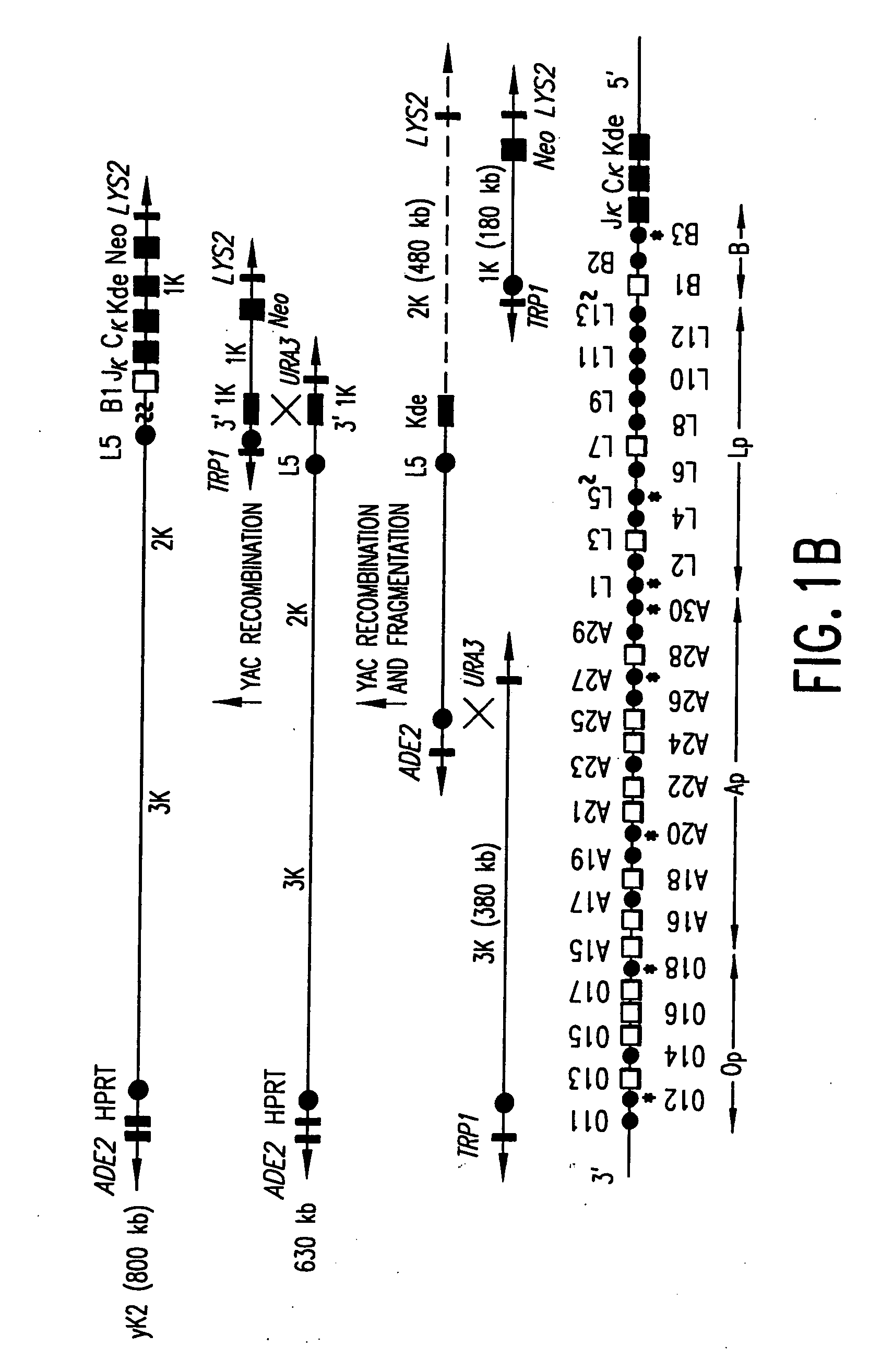Transgenic mammals having human Ig loci including plural Vh and Vk regions and antibodies produced therefrom
a technology of human ig loci and transgenic mammals, which is applied in the field of transgenic nonhuman animals, can solve the problems that the mammals additionally do not produce functional endogenous immunoglobulins, and achieve the effect of reducing the development and maturation of b-cells
- Summary
- Abstract
- Description
- Claims
- Application Information
AI Technical Summary
Benefits of technology
Problems solved by technology
Method used
Image
Examples
example 1
Reconstruction of Human Heavy Chain Loci on YACs
[0116] In accordance with the present invention, the strategy that we utilized to reconstruct the human heavy chain and human kappa light chain variable regions was to, first, screen human-YAC libraries for YACs that spanned the large (megabase-sized) human Ig loci and, second, to recombine YACs spanning such regions into single YACs containing the desired loci predominantly in germline configuration.
[0117] The above, stepwise, YAC recombination scheme exploited the high frequency of meiotic-induced homologous recombination in yeast and the ability to select the desired recombinants by the yeast markers present on the vector arms of the recombined YACs (See FIG. 1, and Green et al., supra.; see also Silverman et al., 1990 and denDunnen et al., 1992).
[0118] In connection with our strategy, we identified four YACs, 1H (240 kb), 2H (270 kb), 3H (300 kb), and 4H (340 kb), which spanned about 830 kb, out of the about 1000 kb, of the huma...
example 2
Reconstruction of Human Kappa Light Chain Loci on YACs
[0120] A similar stepwise recombination strategy was utilized for reconstruction of the human kappa light chain locus. Three YACs were identified that spanned the human kappa loci. The YACs were designated 1K, 2K and 3K. YAC 1K, which had a length of approximately 180 kb, had previously been introduced into our first generation XenoMouse™. Such YAC contained the kappa deleting element, (Kde), the kappa 3′ and intronic enhancers, Cκ, Jκ, and the three Vκ genes on the B cluster (Green et al., 1994; Mendez et al., 1995). YAC 2K (approximately 480 kb), and 3K (approximately 380 kb) together encompass most of the kappa chain proximal variable region on chromosome 2p. A deletion of approximately 100 kb spans the L13-L5 region (FIG. 1B; Huber et al., 1993). Inasmuch as the kappa distal region duplicates the proximal region, and as the proximal Vκ genes are the ones most commonly utilized humans (Weichold et al., 1993; Cox et al., 1994)...
example 3
Introduction of yH2 and yK2 YACs into ES Cells
[0122] In accordance with our strategy, we introduced the YACs, yH2 and yK2, into mouse embryonic stem (ES) cells. Once ES cells containing the YAC DNA were isolated, such ES cells were utilized for the generation of mice through appropriate breeding.
[0123] In this experiment, therefore, YACs yH2 and yK2, were introduced into ES cells via fusion of YAC-containing yeast spheroplasts with HPRT-deficient E14.TG3B1 mouse ES cells as previously described (Jakobovits et al., 1993a; Green et al., 1994). HPRT-positive ES cell clones were selected at a frequency of 1 clone / 15-20×106 fused cells and were analyzed for YAC integrity by Southern and CHEF blot analyses (FIGS. 2A-2E).
[0124] Seven of thirty-five ES cell clones (referred to as L10, J9.2, L17, L18, J17, L22, L23) derived from ES cell fusion with yH2-containing yeast were found to contain all expected EcoRI and BamHI yH2 fragments detected by probes spanning the entire insert: mouse 3′ ...
PUM
| Property | Measurement | Unit |
|---|---|---|
| concentration | aaaaa | aaaaa |
| concentrations | aaaaa | aaaaa |
| lengths | aaaaa | aaaaa |
Abstract
Description
Claims
Application Information
 Login to View More
Login to View More - R&D
- Intellectual Property
- Life Sciences
- Materials
- Tech Scout
- Unparalleled Data Quality
- Higher Quality Content
- 60% Fewer Hallucinations
Browse by: Latest US Patents, China's latest patents, Technical Efficacy Thesaurus, Application Domain, Technology Topic, Popular Technical Reports.
© 2025 PatSnap. All rights reserved.Legal|Privacy policy|Modern Slavery Act Transparency Statement|Sitemap|About US| Contact US: help@patsnap.com



